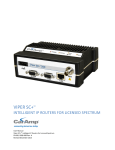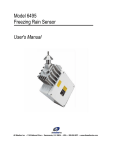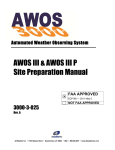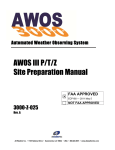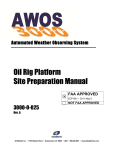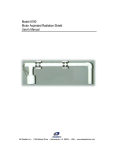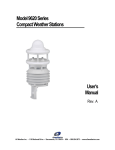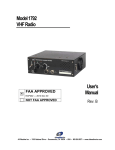Download 20980-A RADIO MODEM USER`S MANUAL
Transcript
20980-A RADIO MODEM USER'S MANUAL All Weather Inc. • 1165 National Drive • Sacramento, CA 95834 • 800.824.5873 • www.allweatherinc.com User's Manual Model 20980-A Radio Modem Contents INTRODUCTION 1 Serial Port ........................................................................................................................1 Programming ...................................................................................................... 1 PHYSICAL CONNECTIONS 1 Antenna Connector......................................................................................................1 Power Connector ..........................................................................................................1 Serial Port Connector....................................................................................................3 LEDs..................................................................................................................................3 LICENSING AND INSTALLATION 4 Licensing .........................................................................................................................4 Installation ......................................................................................................................4 AWOS DCP Installation ....................................................................................... 4 AWOS CDP Installation ....................................................................................... 4 RADIO MODEM ALIGNMENT 4 AWOS PERIODIC MAINTENANCE 5 Monthly Maintenance ..................................................................................................5 CDP ...................................................................................................................... 5 DCP (Tower)......................................................................................................... 5 Quarterly Maintenance................................................................................................5 CDP ...................................................................................................................... 5 DCP (Tower)......................................................................................................... 5 Annual Maintenance....................................................................................................5 CDP ...................................................................................................................... 5 Power Level ........................................................................................................6 VSWR (at transmitter) ........................................................................................6 Frequency ..........................................................................................................6 Deviation ............................................................................................................7 DCP (Tower)......................................................................................................... 7 Page i User's Manual 1.0 Model 20980-A Radio Modem INTRODUCTION The 20980-A is an integrated modem and radio that provides digital data transmission at data rates greater than 19,200 baud (bits per second). Versions are available that operate in both the VHF and UHF frequency bands. The 20980-A is a half duplex unit, meaning that it can receive or transmit, but cannot do both simultaneously. However, two units can be combined to provide full duplex capability. The electrical specifications of the 20980-A are shown in Table 1. The user data interface is a serial port through a 9-pin D connector, and can be configured for either RS-232 or TTL signal levels. The data format is asynchronous with either 8 or 9 data bits. The modem can operate with either the standard DTE/DCE handshake signals or in data activation mode which requires only the receive and transmit data lines. 2.0 MODEM SETUP AND OPERATION 2.1 Serial Port This user interface utilizes a female 9 pin D connector. This is the same serial connector used on many PC AT type computers, except that the computers use a male connector. The modem serial port operates in ADATA activation mode (no handshaking required). The data activation protocol requires the use of only the transmit data (TD) and receive data (RD) lines. When activity is detected on the transmit data line, the transmitter is keyed. The transmitter will remain keyed until there is no activity on the transmit data line for at least 10 character periods. 2.2 Programming Radios are programmed to customer-specified requirements at All Weather Inc. 3.0 PHYSICAL CONNECTIONS 3.1 Antenna Connector The antenna interface to the 20980-A is through a standard 50 ohm female BNC connector. The modem should never be allowed to transmit without connecting either an antenna or dummy load to this connector. A variety of antennas can be used with the 20980-A, but it is important that the antenna used provides a 50 ohm load at the operational frequencies. Any cabling used to remote the antenna must be good quality coaxial cable with 50 ohm characteristic impedance. Depending on the license obtained for operation, there may be restrictions on the type and height of the antenna which may be used. 3.2 Power Connector Power can be fed into the modem either through the Molex connector on the front of the modem or through pin 9 of the serial port (see figure 1). The power into the modem should be a well regulated DC voltage between 9 and 16 volts. The power pin of the Molex and pin 9 of the serial port are directly connected. In most applications, pin 9 of the serial port is either unused (unconnected) or is a ring indicator which is a modem output. For systems operating on RS-232 levels, the power feeding to this pin is in the normal RS-232 voltage range and should not present a problem. For other systems, it may be necessary to leave pin 9 of the serial port unconnected. Page 1 Model 20980-A Radio Modem User's Manual TABLE 1 20980-A RADIO MODEM ELECTRICAL SPECIFICATIONS Data Interface Data Rates Data Format Signal Levels Handshake Protocols Data Only Time Out Data Connector 300, 1200, 2400, 4800, 9600, 19200, 38400 baud Asynchronous; Word length: 7 or 8 bits; Parity: Even, Odd, or None RS-232, TTL (Port 1 only) Full Handshake: Supports RTS, CTS, DCD, DSR, DTR; Data Activation (3 wire): Requires only TXD, RXD, and SG 1 to 500 character periods 9-pin D, female, DCE (std. case) Radio – General Frequency Range Channel Step Size Frequency Stability FCC ID FCC Authorizations IC (Industry Canada) ID IC Authorizations RF Connector 450-470 MHz 6.25, 10 kHz ±1.5 ppm JWFTS4000A (403-512 MHz) 11K2F1D, 16K0F1D, 20K0F1D 3163195426 (403-512 MHz) 11K2F1D, 16K0F1D, 20K0F1D BNC, female, 50 W (std. case) Radio – Transmitter Transmit Power Duty Cycle Attack Time 0.1 to 2 watts (programmable) 50% @2 watts, 100% @0.2 watts and below 20 ms Radio – Receiver Receive Data Sensitivity/ BER (Bit Error Rate) Carrier Detect Threshold Receive Filter Bandwidth Selectivity Spurious/Image Rejection Intermodulation -103 dBm for less than 1x10-4 BER -110 to -60 dBm (programmable) 12.5, 25 kHz -60 dB (12.5 kHz); -70 dB (25 kHz) -70 dB -70 dB General Supply Voltage Power Power Connector Data Buffer Program Storage LED Indicators Operating Temperature Dimensions Weight Page 2 9-28 VDC (full transmit power) 1.0 watts - Standby (typical) 1.5 watts - Receive (typical) 7.0 watts - Transmit (typical) 2-pin Molex or through serial port 32 kByte SRAM 512 kByte Flash ROM (supports in-field firmware upgrades) Transmit, Receive, Power (see section 3.4) -22 to +140° F (-30 to +60° C) 4.3" x 3.1" x 1.8" (109 mm x 79 mm x 46 mm) 12 ounces (340 g) User's Manual Model 20980-A Radio Modem 3.3 Serial Port Connector The serial port connector is a female 9 pin D connector. The cable used to connect to the serial port should be good quality shielded cable with metal connectors. The cable connectors should be securely screwed to the modem’s serial port. 3.4 LEDs The Model 20980-A has three LED indicators to provide operational status of transmit (TX), receive (RX), and power (PWR) functions. Special combinations of these indicators are used to indicate secondary operating modes and fault conditions. 20980-A State LEDs Indicator State Normal Operation PWR RX TX On when the 200980-A is powered On when the 20980-A detects activity on the radio channel On when the 20980-A is transmitting Program Mode RX, TX Both on continuously Reset RX, TX Flash together four times Although the reset indication takes about four seconds to complete, the 20980-A is fully operational when the flashing begins. Transmit Test Mode TX Flashes for the duration of the test Invalid Frequency Channel Fault RX, TX Alternately flash This fault occurs if the 20980-A is set for a channel that does not have a valid frequency programmed. Transmit Buffer Overflow TX Flashes ten times for each occurrence Receive Buffer Overflow RX Flashes ten times for each occurrence Diagnostics Fault PWR Flashes for the duration of the fault In this mode the 20980-A has detected a fault but continues to operate. Operation may be unreliable due to the fault. The most common cause of this state is an out-of-range power source. the source of the fault can be diagnosed with the configuration program. Catastrophic Fault RX, TX Alternately flash until the fault is cleared and the 20980-A is reset In this mode the 20980-A has detected a catastrophic fault and is non-operational until the fault is corrected. The source of the fault can be diagnosed with the configuration program. Page 3 Model 20980-A Radio Modem User's Manual 4.0 LICENSING AND INSTALLATION 4.1 Licensing The 20980-A operates on frequencies which are regulated by the Federal Communications Commission (FCC). Therefore, it is necessary to obtain a license before this equipment is operated on the air. In general this is not a difficult process, and All Weather Inc. can aid with any issues or questions relating to licensing. The 20980-A has been tested and found to comply with the limits for a Class B digital device, pursuant to Part 15 of the FCC rules (Code of Federal Regulations 47CFR Part 15). Operation is subject to the condition that this device does not cause harmful interference. The 20980-A has been type accepted for operation by the FCC in accordance with Part 90 of the FCC rules (47CFR Part 90). See the label on the unit for the specific FCC ID and any other certification designations. the 20980-A has bee type accepted for operation by the FCC in accordance with Part 101 of the FCC rules (47CFR Part 101). See the label on the unit for the specific FCC ID and any other certification designations. Any changes or modifications to this equipment not expressly approved by All Weather Inc. could void the user’s authority to operate this equipment (FCC rules, 47CFR Part 15.21). 4.2 Installation To ensure proper and satisfactory operation, the 20980-A should only be installed by qualified professionals. 4.2.1 AWOS DCP Installation Attaches to the DCP Sensor Interface board. Refer to the Model 1190 DCP User's Manual for installation instructions. 4.2.2 AWOS CDP Installation Refer to the Model 2090 CDP User's Manual for installation instructions. 5.0 RADIO MODEM ALIGNMENT The 20980-A should be aligned and serviced only by certified technicians. Making internal adjustments can cause incorrect operation, illegal emissions, damage to the unit, and can also void the manufacturer’s warranty. The 20980-A radio modem is aligned and tested at All Weather Inc. prior to shipment. Each 20980A Radio Modem shipped from the factory is configured for the following operation: Baud Rate 9600 Character Length: 8 bits Serial Configuration: Enhanced Data Scrambling: On Handshake Protocol: Data Activation Time Out Timer: Off Serial Data Signal Level: RS-232 Page 4 User's Manual Model 20980-A Radio Modem Synthesized 20980-A Radio Modems are shipped with channel 1 programmed to the site specific receive and transmit frequency. 6.0 AWOS PERIODIC MAINTENANCE When this instrument is installed in an AWOS system, periodic maintenance and verification must be carried out according to a schedule that includes monthly, quarterly, and annual procedures. 6.1 Monthly Maintenance 6.1.1 CDP • Inspect the antenna and cables for damage. Repair or replace damaged components. • Select the DCP status display screen from the Maintenance Menu, and verify that the displayed ratio of CRC errors to properly received data packets is less than 10%. • If the ratio of errors to good data is greater than 10%, adjust the antenna position and verify there are no obstructions between the sensor tower and the receiving antenna. If the problem persists, replace the radio. • On the DCP status display screen, verify that the timeout error percentage is less than 5%. • If the timeout error percentage is greater than 5% but some data is being received properly, adjust the antenna position and verify there are no obstructions between the sensor tower and the receiving antenna. If the problem persists, replace the radio. • If the timeout error percentage is greater than 5% and no data is being received, verify that the CDP radio is powered and that the interface cables are connected properly to the PC. If no problem is found, verify that the sensor tower radio is powered and connected properly. If no problem is found, replace both the CDP and DCP (sensor tower) radios. 6.1.2 DCP (Tower) • Inspect the antenna and cables for damage. Repair or replace damaged components. • Inspect the radio. Verify that the Transmit and Receive LEDs flash at 5-second intervals. • Select the date and time screen on the DCP keypad. Verify that the date and time are correct and that the time updates at 5-second intervals. • If the time is updated less frequently (e.g., every 15-30 seconds or longer) adjust the antenna position and verify there are no obstructions between the tower and the transmitting antenna (located near the CDP). If the problem persists, replace the radio. 6.2 Quarterly Maintenance 6.2.1 CDP For quarterly maintenance, perform the monthly maintenance procedures described above. 6.2.2 DCP (Tower) For quarterly maintenance, perform the monthly maintenance procedures described above. 6.3 Annual Maintenance 6.3.1 CDP Annual maintenance and validation of the Model 20980-A UHF Radio located at the CDP consists of the following tests: • • • Power level VSWR (at the transmitter) Frequency Page 5 Model 20980-A Radio Modem • User's Manual Deviation 6.3.1.1 Power Level 1 Remove power from the UHF radio by disconnecting the DB9 connector. 2 Connect a power meter between the connector on the radio and the cable to the antenna. 3 Place the 2.5 watt 400-850 MHz frequency element in the power meter. The element arrow shall point to the antenna. 4 Reconnect the DB9 connector to restore power to the UHF radio. Measure the forward power on the power meter. This should be approximately 1W. Enter the value on the data sheet. 6.3.1.2 VSWR (at transmitter) 1 Replace the power element with a 1 watt 275-450 MHz frequency element with the arrow in the direction of the radio. NOTE: Damage will occur to the element if the arrow is in the direction of the antenna. 2 Measure the reflected power. Enter the value on the data sheet. 3 Calculate the VSWR from Figure 1 and enter the value on the data sheet. 1+ reflected power forward power 1− reflected power forward power VSWR = Sample calculation: reflected power = .02 W forward power = 5 W reflected power forward power .02 1 + .004 1 + .063 1.063 5 = VSWR = = = = = 1.134 VSWR reflected power .02 1 − .004 1 − .063 .937 1− 1− 5 forward power 1+ 1+ Figure 1 VSWR Calculation 6.3.1.3 Frequency 1 Replace the power element with the RF sampler element. 2 Connect an RG-58 coaxial cable from the sampler to the frequency meter. 3 Set the frequency meter to "500" MHz range, "fast" gate, and "batt" power. 4 Measure and log the frequency on the data sheet. Page 6 User's Manual Model 20980-A Radio Modem 6.3.1.4 Deviation 1 Replace the frequency meter with the deviation meter. 2 Connect the coaxial cable to the RF input on the meter. Set the meter switches to: Function Range Filter De-emphasis Power 3 FM + 10 KHz 25-15 KHz Off On Enter the meter reading on the data sheet. 6.3.2 DCP (Tower) Repeat the annual maintenance procedures described above for the CDP on the radio installed at the DCP (tower site). Page 7 All Weather Inc. 1165 National Drive Sacramento, CA 95834 Fax: 916.928.1165 Phone: 916.928.1000 Toll Free: 800.824.5873 www.allweatherinc.com 20980-A01 Revision B ECO 1077










